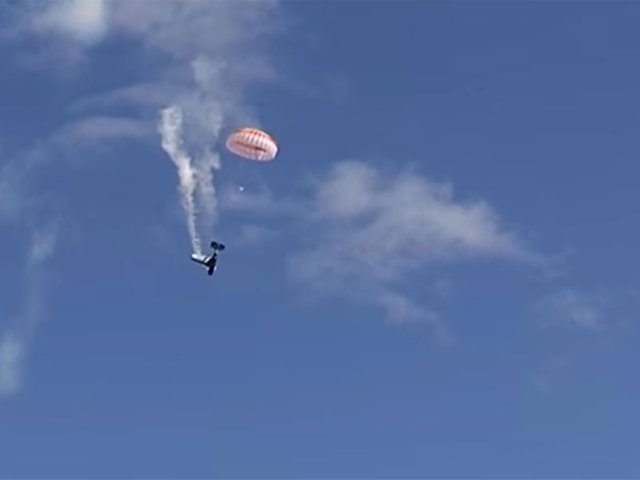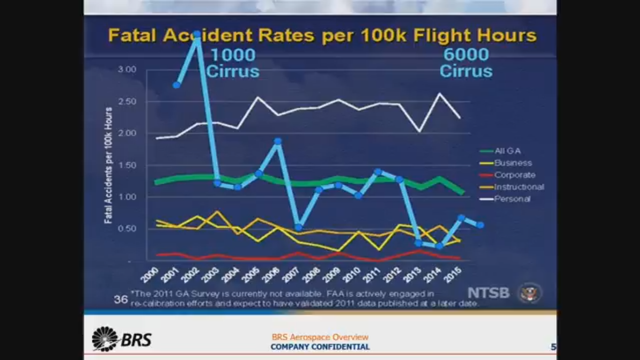Scientific innovations for human problems [Safety devices]. Aircraft ballistic parachutes

In this post I present you WARPS (Whole Aircraft Rescue Parachute System) developed by BRS (Ballistic Recovery Systems, Inc.).
The company was founded by Boris Popov in 1980. In 1975 he survived after falling from 120 m height with hang glider. That inspired him to build such a system.
This system is a type of ballistic parachute system (the one that is ejected with the help of small explosion (similar to ejection seat)). It’s usually attached to light aircraft (with takeoff weight of 5,670 kg or less) and hang gliders [1, 2, 3].
Ballistic means relating to ballistics
the science of projectiles and firearms
(Oxford Dictionary of English, 3rd Edition, Oxford University Press 2010)
The first WARPS became available in 1982. And you see that this series of posts is about innovations.
I intentionally mentioned in the previous post of this series that
According to “Oxford Dictionary of English” (3rd Edition, 2010) an innovation is simply
a new method, idea, product, etc.
source
So, innovation isn’t about the age. Aforementioned parachute systems haven’t been improved drastically since that time (1980-1982). Thus, I consider such parachute systems as innovations (hope you agree with me).
Two main components of such system is parachute itself (obviously) and a rocket (which helps to open parachute within seconds).
The basic principle is that this system works as a handbrake, but for aircrafts.
Here’s an amazing demonstration of this system (I suggest you to watch beginning from the 2nd minute)
Note that after landing the aircraft got on fire after a while. Just imagine if this happened in the air. That parachute system would be useless (the pilot would die/burn in the air). And this wouldn’t happen in the case of ejection seat usage.
Pilots launch these systems by pulling a special deployment handle (I guess pilots could be ejected accidentally sometimes, if buttons were used instead).
Tests have shown that a 12 year old girl can activate the deployment handle.
source
I hope it wasn’t young Lucia Rijker ("The Most Dangerous Woman in the World").
BRS parachute systems are designed mostly to two types of aircraft, namely Cirrus SR20/Cirrus SR22 and Cessna 172 (the most successful aircraft in the history of humanity btw (more than 44,000 aircrafts built since 1956)) / Cessna 182. The systems have been installed on more than 35,000 aircrafts [4, 5].
WARPS weights near 80 pounds (1 pound = 0.4536 kg) and can be installed in 40-45 hours (for more information go to FAQ).
One more video to watch the system in action…
The following image shows fatal accidents rates reduction achieved with the help of WARPSs (for aforementioned Cirrus (blue polygonal line)).

source
For detailed explanation from the founder
Those systems seem as cool and effective solution. But BRS official web-site says that
403 LIVES SAVED SO FAR
source
… since 1982…
What about installing ejection seats and those parachute systems on airliners?
Parachute systems for airliners
Ok, what about parachute systems for airliners (those aircrafts with more than 14 passengers)?
Really, why not just install that same parachute system (much bigger) on them?
There’s a great web-site with detailed explanation on why it’s not a good idea to install neither ejection seats nor parachute systems on airliners.
In a nutshell, I mentioned that light aircrafts are those with takeoff weight of near 3000 pounds (near 5500 kg).
At the same time airliners like Boeing 747 can have takeoff weight near 735,000 pounds (near 330,000 kg) [6].
Just imagine what a huge parachute system would be needed for such a giant.
Airliner could be separated into sections with their own parachute systems, though.
Even though this is viable it is not likely to be built! The costs would be very large, the modifications to the airframe extensive, and the percent chance that it would or could be used to positive effect so low that it is unlikely that aircraft company would find it economically feasible.
source
This is the problem of monetary system, though.
Another problem mentioned on aforementioned website is that
The majority of airliner disasters occur at low altitude, usually during takeoff/landing…
So, there’s just no sense to install parachute systems, because there just wouldn’t be enough time for them to work (in most cases).
Now I’d like to talk a little bit about the safety.
Aviation safety vs. road traffic safety
Now, there’re many sources to get statistical data on the numbers of accidents/fatalities happening with the passengers of airliners.
I got some data from
https://aviation-safety.net/statistics/period/stats.php
You can see that in 1960-1980 more than a thousand of people dead constantly.
In 2010-2019 this number is less than a thousand. Seems like some improvements were made.
In 2018 there were 561 airliner fatalities and 11 airliner accidents.
Approximately 1.35 million people die each year as a result of road traffic crashes.
source
To my knowledge, when airliners accidents happen, mass media thoroughly discuss that for a long time.
Also in airliner accident usually a lot of people die. It seems like quite dramatic/emotional event.
This is not the case when it comes to road traffic accidents.
As far as I remember, this is called “What You See Is All You Have” principle.
(for more information -> Daniel Kahneman. Thinking, Fast and Slow. 2011)
The trick is that it’s easy to remember arresting event (airliner accidents).
But you see, we have 561 (airliner fatalities) vs. 1.35 million (road traffic fatalities) per year (2018).
Another possible explanations on why people usually afraid of flights is that in that case your life is out of your control (unless you have a private parachute system (or ejection seat)) (and in cars you have more control over your own life).
Ejection seats for airliners
As for ejection seats, in a nutshell, the seats would have to be jettisoned in such a way, so that there weren’t any collisions between them in the air (separation of different rows should have happened with delays). That would have led to the changes of the airliner’s center of gravity. Also due to jettisoning of hatches in the roof aerodynamics would have been drastically changed. All this would have led to flight control problems. Also all those ejection seats would have add a lot of weight to the airliner. And all those ejection seats would have been adjusted specially for each passenger, and all those passengers should have been trained to use those seats.
For more information go to http://www.ejectionsite.com/eairliner.htm
Conclusion
Passenger survival by separating the passengers from the aircraft prior to impact is not an option that could be easily or cost effectively implemented. In my opinion, crash prevention and improving survivability of the airframe would be a better use of funds. If a plane does not crash usually the survival rate is 100%!!! In the case where an aircraft does crash, if the passengers are not killed or immobilized by the impact, they have a good chance of survival if they can egress the wreckage quickly! Smoke and fire are the main killers of people after a 'survivable' impact.
source
All images (without the license specified)/videos are used under the doctrine known in USA as "Fair Use" (similar doctrines are used in other countries). For more information visit the US Gov website